Planting Near Power Lines - City of Nelson
Planting Near Power Lines - City of Nelson
Planting Near Power Lines - City of Nelson
You also want an ePaper? Increase the reach of your titles
YUMPU automatically turns print PDFs into web optimized ePapers that Google loves.
A guide to trees<br />
recommended for<br />
planting and growing<br />
near power lines<br />
<strong>Planting</strong> <strong>Near</strong> <strong>Power</strong> <strong>Lines</strong><br />
June 2000<br />
L i v i n g w i t h T r e e s
Living<br />
with<br />
trees<br />
BC Hydro has one <strong>of</strong> the most efficient systems in<br />
the world to distribute electricity to the homes and<br />
work places <strong>of</strong> more than three million British<br />
Columbians. Still every year our customers are<br />
inconvenienced by power outages caused by trees.<br />
In fact, trees account for more than half <strong>of</strong> all power<br />
interruptions, and tree damage to power lines can<br />
create severe public safety hazards such as fires or<br />
electrocution. We spend more than 20 million dollars<br />
annually to deal with tree and power line problems.<br />
Two solutions are removing weak or hazardous<br />
trees and encouraging the regular pruning <strong>of</strong> trees<br />
near power lines.<br />
At the same time, Hydro recognizes the practical<br />
and aesthetic value <strong>of</strong> trees to our homes and our<br />
communities. We encourage the planting and maintaining<br />
<strong>of</strong> trees, even those close to power lines,<br />
provided that the tree is appropriate for that location.<br />
2 <strong>Planting</strong> <strong>Near</strong> <strong>Power</strong> <strong>Lines</strong>
The right tree<br />
in the right place<br />
BC Hydro is pleased to have trees planted beside or<br />
even directly under power lines, provided that the<br />
tree is a species that will not reach to such height<br />
or width that it will grow into or fall on power lines.<br />
This guide is designed to assist you in selecting<br />
beautiful trees and shrubs for planting, without<br />
creating potential hazards for yourself or your<br />
neighbours.<br />
There are three planting zones <strong>of</strong> concern:<br />
Low zone<br />
is the area directly under the power lines and<br />
extends five metres on either side <strong>of</strong> the hydro pole.<br />
Trees planted in this area should have a maximum<br />
mature height <strong>of</strong> six metres or less.<br />
Medium zone<br />
is the area that extends from the edge <strong>of</strong> the low<br />
zone to a distance <strong>of</strong> 20 metres from the hydro pole.<br />
Trees in this zone cause the majority <strong>of</strong> outages.<br />
Weak or damaged trees in particular create a potential<br />
for severe public safety hazards. The maximum<br />
height <strong>of</strong> trees growing in this zone should be<br />
12 metres. This could provide a beautiful landscape<br />
without creating safety problems.<br />
Tall zone<br />
is the area more than 20 metres from the power<br />
lines. Virtually any strong healthy tree is acceptable<br />
in this zone.<br />
<strong>Planting</strong> <strong>Near</strong> <strong>Power</strong> <strong>Lines</strong> 3
How to use this guide<br />
Locate your geographic region in the extreme, cold,<br />
moderate or mild winter areas. Determine if your<br />
planting site is in the low, medium or tall zone. If<br />
you are planting in the low or medium tree zones,<br />
consult the lists under your geographic region for<br />
recommended species appropriate for planting in<br />
these locations. Your local garden centre can provide<br />
further information and assist you in selecting the<br />
right tree for the right location.<br />
MILD<br />
MODERATE<br />
COLD<br />
EXTREME<br />
Note:<br />
Theoretically, any tree that can<br />
survive in an extreme or cold<br />
winter region can survive in a<br />
moderate or mild winter region.<br />
Some trees however, adapt better<br />
to cooler and/or dryer weather<br />
conditions. Before selecting a tree<br />
recommended for a colder winter<br />
climate, check with the plant specialist<br />
at your local garden centre.<br />
Cities and Towns <strong>of</strong> British Columbia located in:<br />
Extreme winter areas<br />
Atlin, Burns Lake, Chetwynd, Dawson Creek, Fort<br />
St. John, Fort St. James, Fort <strong>Nelson</strong>, MacKenzie,<br />
Smithers, Vanderho<strong>of</strong>.<br />
Cold winter areas<br />
Cranbrook, Golden, Invermere, Kimberley, McBride,<br />
Merritt, 100 Mile House, Prince George, Quesnel,<br />
Tulameen, Whistler, Williams Lake.<br />
Moderate winter areas<br />
Cache Creek, Fernie, Grand Forks, Hope, Lillooet,<br />
Lytton, Kamloops, Kelowna, Nakusp, <strong>Nelson</strong>, New<br />
Hazelton, Revelstoke, Salmon Arm, Terrace, Trail,<br />
Vernon.<br />
Mild winter areas<br />
Bella Coola, Fraser Valley, Kitimat, Lower Mainland,<br />
Powell River, Prince Rupert, Sandspit, Sechelt,<br />
Squamish, Vancouver Island.<br />
4 <strong>Planting</strong> <strong>Near</strong> <strong>Power</strong> <strong>Lines</strong>
Selecting the right tree<br />
When selecting a tree there are special considerations to take into account.<br />
Location - The distance the tree will be from houses, structures, sidewalks and power lines.<br />
- The location <strong>of</strong> underground utilities or drains that might interfere with the tree’s roots.<br />
Species - The direction <strong>of</strong> growth and aesthetic look <strong>of</strong> the tree when it matures.<br />
- Maintenance requirements, e.g. pruning, disease and insect problems associated with<br />
the tree species.<br />
Survival - The hardiness <strong>of</strong> the tree species related to the climate.<br />
- The adaptability <strong>of</strong> the tree species to different climate conditions.<br />
- Wind-chill and other factors that could affect the survival <strong>of</strong> the tree species.<br />
If you have questions about the suitability <strong>of</strong> any tree species you wish to plant, consult the staff at your local<br />
garden centre before making final selections.<br />
&<br />
Common names<br />
Scientific names<br />
All <strong>of</strong> the trees detailed in this brochure are listed in their respective categories by scientific<br />
name in alphabetic order. Many trees have different or many common names. Some <strong>of</strong> the<br />
common names are listed below. Beside each is the scientific name (genus). Information about<br />
the tree or shrub is detailed on the following pages under the scientific name.<br />
Common<br />
arborvitae<br />
beauty bush<br />
bladdernut<br />
bridal wreath<br />
butterfly bush<br />
cedar<br />
cherry<br />
chokecherry<br />
cornelian cherry<br />
crabapple<br />
cranberry bush<br />
dogwood<br />
elder/elderberry<br />
emerald cedar<br />
false holly<br />
golden chain<br />
goldenrain tree<br />
hawthorn<br />
holly<br />
hornbeam<br />
Japanese plum yew<br />
katsura<br />
laurel<br />
lilac<br />
Scientific (genus)<br />
Thuja ▲<br />
Kolkwitzia<br />
Staphylea<br />
Spiraea ▲<br />
Buddleia<br />
Thuja ▲<br />
Prunus ▲<br />
Prunus ▲<br />
Cornus ▲<br />
Malus ▲<br />
Viburnum<br />
Cornus ▲<br />
Sambucus ▲<br />
Thuja ▲<br />
Osmanthus<br />
Laburnum<br />
Koelreuteria<br />
Crataegus ▲<br />
Ilex<br />
Carpinus<br />
Cephalotaxus<br />
Cercidiphyllum<br />
Prunus ▲<br />
Syringa<br />
Common<br />
magnolia<br />
maple<br />
mock orange<br />
mountain ash<br />
oak<br />
Persian ironwood<br />
plum<br />
pyramidalis<br />
quince<br />
redbud<br />
Russian olive<br />
Saskatoon berry<br />
serviceberry<br />
Siberian peashrub<br />
Smaragd<br />
smoke tree<br />
snowball tree<br />
snowbell tree<br />
sorrel tree<br />
spindle tree<br />
staghorn<br />
sumac<br />
witchhazel<br />
yew<br />
Scientific (genus)<br />
Magnolia<br />
Acer ▲<br />
Philadelphus ▲<br />
Sorbus ▲<br />
Quercus ▲<br />
Parrotia<br />
Prunus ▲<br />
Thuja ▲<br />
Chaenomeles<br />
Cercis<br />
Elaeagnus<br />
Amelanchier ▲<br />
Amelanchier ▲<br />
Caragana<br />
Thuja ▲<br />
Cotinus<br />
Viburnum<br />
Styrax<br />
Oxydendrum<br />
Euonymus<br />
Rhus<br />
Rhus ▲<br />
Hamamelis<br />
Taxus ▲<br />
The attached lists are <strong>of</strong> trees which are available in B.C. nurseries. As new stock is constantly being added,<br />
there may be other choices available to you. Consider planting low growing native species when selecting<br />
trees. Native trees and shrubs <strong>of</strong>fer a number <strong>of</strong> advantages over imported exotics. Genera with a triangle<br />
(▲) next to their name have at least some native species.<br />
<strong>Planting</strong> <strong>Near</strong> <strong>Power</strong> <strong>Lines</strong> 5
Trees recommended for planting in<br />
extreme winter areas<br />
Low zone<br />
Acer ginnala (Amur maple)<br />
Growth up to six metres. Small tree, one <strong>of</strong> the few maples<br />
with fragrant blossoms. Excellent fall colour (yellow to brilliant<br />
red). Good spread, very hardy.<br />
Amelanchier alnifolia (serviceberry, Saskatoon)<br />
Small tree or shrub, <strong>of</strong>ten multi-stemmed. White flowers and<br />
purplish edible fruit. Makes great pies and jellies.<br />
Caragana arborescens (Siberian peashrub)<br />
A fine small tree or shrub with bright yellow flowers grown on<br />
previous years wood. Very hardy and versatile, many cultivars<br />
available.<br />
Cornus alba (Tartarian Siberian dogwood)<br />
Growth up to four metres. A fine hardy shrub that is attractive<br />
in winter and summer. Deep red stems give winter show.<br />
Many cultivars.<br />
Cornus baileyi (red stem dogwood)<br />
Growth up to three metres. Attractive shrub during summer<br />
and winter, when red stems make a showy winter scene.<br />
Juniperus communis (dwarf juniper)<br />
Average growth 4.5 metres. Excellent evergreen small tree or<br />
shrub. Tremendously hardy particularly in cold. Many cultivars.<br />
Pinus mugo (Mugo pine)<br />
Growth between 5 - 6 metres. Excellent cold weather pine.<br />
Pyramidal cultivars available, may also be a broad shrub or<br />
small tree.<br />
Prunus virginiana (Western chokecherry)<br />
Growth up to six metres. Small tree or multi-stemmed shrub.<br />
Attractive foliage and white flowers with showy red fruit<br />
turning to dark purple. Excellent for jellies and wines.<br />
Salix discolor (pussy willow)<br />
Growth up to five metres. Willow shrub, early catkins in<br />
spring, full thick foliage through summer.<br />
Salix pyrifolia (balsam willow)<br />
Growth up to six metres. Grows best in boggy areas, has a<br />
balsam fragrance.<br />
Sambucus racemosa (elder)<br />
Growth up to four metres. Attractive elderberry shrub with<br />
flowers and berries. Choose cultivars adapted to planting<br />
area.<br />
Acer ginnala<br />
Sorbus americana (American mountain ash)<br />
Growth up to 4 - 6.5 metres. Northern species <strong>of</strong> mountain<br />
ash. Well adapted to cold weather areas, handles wet or dry<br />
soil. Flowers white, fruit bright red.<br />
Syringa vulgaris (lilac)<br />
Beautiful and aromatic lilac is a favorite the world over.<br />
Choose a variety adapted to your planting area. Your garden<br />
centre will have them.<br />
Tamarix ramosissima (tamarix)<br />
Growth up to five metres. Summer flowering shrub is very<br />
adaptable and also salt tolerant. Beside a roadway, this<br />
attractive shrub is a good choice.<br />
Taxus canadensis (Canadian yew)<br />
Excellent species, hardy and attractive yew. Difficult to locate,<br />
but your garden centre may be able to locate these fine evergreens<br />
for you.<br />
Viburnum trilobum (cranberry bush)<br />
Growth up to four metres. Attractive summer flowers and<br />
winter berries make this hardy shrub a sound power line<br />
companion.<br />
Amelanchier<br />
Medium zone<br />
Acer glabrum ‘Var.Douglasii’ (Douglas maple)<br />
Average growth up to eight metres at maturity. An attractive<br />
and hardy maple, available in many varieties.<br />
Elaeagnus angustifolia (Russian olive)<br />
Grey and green foliage makes this hardy tree an outstanding<br />
feature for front yards and a good medium zone power line<br />
companion.<br />
Prunus spp. (Flowering cherries, plums)<br />
Equally popular flowering cherries and plums give wonderful<br />
spring blossoms. Many have excellent leaf colour. Always<br />
check with your local nursery pr<strong>of</strong>essional for disease free<br />
varieties developed for your area.<br />
Salix spp. (willows)<br />
Another prolific species from which many attractive cultivars<br />
have been developed.<br />
6 <strong>Planting</strong> <strong>Near</strong> <strong>Power</strong> <strong>Lines</strong>
Trees recommended for planting in<br />
cold winter areas<br />
(in addition to trees listed in Extreme Winter areas for low and medium zones)<br />
Low zone<br />
Acer griseum (Paperbark maple)<br />
Maximum growth six metres. Slow growing tree. Winter bark<br />
peeling creates dormant interest. Excellent power line<br />
companion.<br />
Chamaecyparis pisifera ‘Filifera’ (thread leaf cypress)<br />
Growth to five metres. Evergreen cultivar is columnar in<br />
shape and very hardy. Available in light, dark green and gold<br />
tips. Used throughout the world as a feature plant, makes an<br />
attractive power line tree.<br />
Cornus sericea (golden twig dogwood)<br />
Growth up to three metres. Similar to baileyi with brilliant<br />
yellow stem varieties.<br />
Corylus americana (filbert)<br />
Growth up to six metres. Attractive multi-stemmed tree.<br />
Good shape when it matures and the nuts are edible.<br />
Crataegus spp. (hawthorn)<br />
Growth up to six metres. Beautiful flowers and berries on a<br />
thorny tree. Consult with a nursery pr<strong>of</strong>essional regarding an<br />
area adapted variety.<br />
Euonymus alatus (Burning bush)<br />
Great shrub for fall colours. Bright orange-red berries.<br />
Ilexxmeserveae(Northern holly)<br />
Growth up to six metres. Hardy holly shrubs available in varieties<br />
adapted to local weather conditions.<br />
Philadelphus x virginalis (mock orange)<br />
Growth between 3 - 4 metres. A pr<strong>of</strong>usion <strong>of</strong> creamy white<br />
flowers covers this hardy shrub which is a great species for<br />
planting in limited space.<br />
Rhus typhina (staghorn sumac)<br />
Sumacs are hardy, prolific and small enough to be under<br />
power lines. An attractive tree with bright fall colours.<br />
Staphylea trifolia (bladdernut)<br />
Sometimes hard to find in a nursery, this attractive tree and<br />
shrub is a year round delight with foliage, flowers, fruits and<br />
nuts.<br />
Malus<br />
Syringa reticulata (Japanese tree lilac)<br />
Growth up to six metres. Small tree, exfoliating bark on short<br />
stem. Oval crown with highly scented yellowish white flowers.<br />
Thuja occidentalis (Arborvitae, White cedar)<br />
Growth up to 4.5 metres. Choose one <strong>of</strong> the low growing varieties<br />
<strong>of</strong> this popular plant for hedging or feature trees.<br />
Acer campestre<br />
Medium zone<br />
Acer campestre (Hedge maple)<br />
Growth up to 12 - 16 metres. Attractive round-headed tree.<br />
Acer tataricum (Tatarian maple)<br />
Growth up to 10 metres. Small attractive tree, with red fruit<br />
in late summer and bright green leaves that turn yellow in<br />
fall.<br />
Amelanchier spp. (serviceberry)<br />
A number <strong>of</strong> hardy varieties <strong>of</strong> the attractive white-flowered<br />
serviceberry are available in each hardiness zone.<br />
Cercis canadensis (redbud - judas tree)<br />
Growth up to 10 metres. Showy choice in a wonderful flowering<br />
tree. Available in purple and white (‘Alba’) flowers.<br />
Cornus mas (Cornelian cherry - dogwood)<br />
This hearty dogwood has clusters <strong>of</strong> yellow flowers in early<br />
spring before leaves are on the tree. Adaptable, hardy and<br />
showy.<br />
Euonymus europaeus (spindle tree)<br />
This tree changes colour throughout the year and always creates<br />
interest.<br />
Malus spp. (Flowering crabapple)<br />
Everyone loves the beautiful flowering crabapples when they<br />
bloom in spring and <strong>of</strong>ten their small fruits provide winter<br />
attraction. Crabapple varieties have been developed for all<br />
conditions. Your local nursery pr<strong>of</strong>essional will show you<br />
trees suitable for your planting site.<br />
CAUTION: Malus spp. (flowering crabapple) is host to the<br />
Apple codling moth and should not be planted in the<br />
Okanagan or other apple growing regions. Always consult<br />
with your local nursery when planting trees in areas where<br />
commercial fruit crops are grown.<br />
<strong>Planting</strong> <strong>Near</strong> <strong>Power</strong> <strong>Lines</strong> 7
Trees recommended for planting in<br />
moderate winter areas<br />
(in addition to trees listed in Cold Winter areas for low and medium zones)<br />
Low zone<br />
Acer palmatum (Japanese maple)<br />
Few trees <strong>of</strong>fer the attractiveness <strong>of</strong> this fine species. Ideal in<br />
either moderate or mild winter areas and available with red<br />
or green foliage. A great choice for a power line companion.<br />
Acer circinatum (vine maple)<br />
B.C. native vine maple usually grows in clumps and <strong>of</strong>fers an<br />
attractive green foliage only outdone by its brilliant fall<br />
colour.<br />
Chaenomeles japonica (Japanese quince)<br />
Large red, pink or white blossoms announce the spring with<br />
this fine shrub. Easily trainable, it makes a thick and attractive<br />
shrub.<br />
Cotinus coggygria (smoke tree)<br />
The silk-like thread flowers <strong>of</strong> this handsome tree appear like<br />
smoke hovering over its attractive foliage. Available in green<br />
or purple, this will be a conversation piece in your front garden.<br />
Forsythia x intermedia (border forsythia)<br />
A hardy plant with reams <strong>of</strong> bright yellow early-spring<br />
blossoms.<br />
Hamamelis x intermedia (witchhazel)<br />
Hardy shrub with winter bloom, x intermedia has several<br />
varieties and several colours available.<br />
Hamamelis mollis (Chinese witchhazel)<br />
Brilliant yellow blooms are featured on this “best <strong>of</strong> breed”.<br />
Juniperus spp. (dwarf junipers)<br />
Many suitable and attractive varieties to choose in this evergreen<br />
family.<br />
Kolkwitzia amabilis (beauty bush)<br />
Growth up to four metres. The common name is right on for<br />
this handsome shrub with pink and white bell-like flowers.<br />
Magnolia stellata (star magnolia)<br />
Growth up to 3.5 metres. The small start-like flowers cover<br />
this magnolia in early spring. An excellent choice.<br />
Rhododendron spp. (rhododendron)<br />
Growth <strong>of</strong> some varieties up to four metres. Hundreds <strong>of</strong> varieties<br />
to choose from in this popular attractive shrub, large<br />
blossoms and a wide variety <strong>of</strong> colours.<br />
Spiraea prunifolia ‘Arguta’ (bridal wreath)<br />
A wonderful spring flowering plant with masses <strong>of</strong> white<br />
flowers.<br />
Thuja orientalis (oriental arborvitae)<br />
Not recommended for coastal areas. Choose one <strong>of</strong> the low<br />
growing varieties <strong>of</strong> this fine evergreen for under power line<br />
planting, or maintain as a hedge. Lots <strong>of</strong> variety to choose<br />
from.<br />
MEDIUM ZONE<br />
Cercidiphyllum japonicum (katsura tree)<br />
The shape and colour <strong>of</strong> the foliage and the interesting bark<br />
effects make the Katsura a beautiful feature tree.<br />
Cornus “Eddie’s White Wonder” (Eddie’s dogwood)<br />
Eddie’s dogwood is covered in blooms in the spring and is<br />
very resistant to the dogwood leaf-blotch blight which effects<br />
the native “nuttallii”. The choice for coastal planting <strong>of</strong><br />
dogwood.<br />
Cornus florida (Flowering dogwood)<br />
Cultivars give you some flower colour choices in this attractive<br />
tree.<br />
Cornus kousa ‘chinensis’ (Chinese dogwood)<br />
Large creamy white bracts light up this tree which prefers<br />
light shade.<br />
Ilex crenata (Japanese holly)<br />
More shrub-like holly variety with simple leaves. Fruits black<br />
and less obvious than with aquifolium or opaca.<br />
Koelreutaria paniculata (goldenrain tree)<br />
Very attractive summer flowering tree with bright yellow<br />
flowers. An excellent choice for a feature tree.<br />
Laburnum watereri ‘vossii’ (golden chain)<br />
Wonderful flowering chains <strong>of</strong> yellow flowers on this fine tree.<br />
Very attractive. CAUTION: Flowers, fruits and seeds are<br />
extremely poisonous.<br />
Magnolia x soulangiana (saucer magnolia - tulip tree)<br />
Growth up to 10 - 15 metres. Fragrant brilliant flowers fill<br />
this tree in May. White tips with pink or purple bottoms.<br />
Oxydendrum arboreum (sorrel tree)<br />
Lustrous leaves turn brilliant red in fall. Occasionally hard to<br />
find, but an interesting addition to any garden.<br />
Parrotia persica (Persian ironwood)<br />
One <strong>of</strong> the best small specimen trees. Interesting foliage and<br />
bark make it a conversation piece. Very problem resistant.<br />
Prunus x blireana (Blireana plum)<br />
If you want a fine showy tree, you should consider Prunus.<br />
Blireana is just one <strong>of</strong> the stars in an extremely showy family.<br />
Sorbus aucuparia (European mountain ash)<br />
White flowers in spring, red berries in the fall and is a bird<br />
feeder in colder winters. Excellent single tree feature.<br />
Stewartia sinensis (Chinese stewartia)<br />
Very handsome large shrub with white flowers and yellow stamens.<br />
Styrax japonica (Japanese snowball)<br />
A great June flowering small tree or shrub. Prefers light shade.<br />
Taxus spp. (yew)<br />
In evergreen shrubs and small trees, the yews have a lot to<br />
<strong>of</strong>fer. CAUTION: Very toxic leaves and berries.<br />
Note:<br />
Flowering Cherries are prohibited from being planted<br />
in the “Little cherry” control area <strong>of</strong> the Central<br />
Interior. This includes the entire Okanagan Valley,<br />
north to Kamloops and Salmon Arm and south to<br />
Princeton and Osoyoos. There is also a “Little cherry<br />
control area” in the Creston area. Check with your<br />
local nursery.<br />
8 <strong>Planting</strong> <strong>Near</strong> <strong>Power</strong> <strong>Lines</strong>
Trees recommended for planting in<br />
mild winter areas<br />
(in addition to trees listed in Moderate Winter areas for low and medium zones)<br />
Low zone<br />
Acer griseum (paperbark maple) - refer to previous list.<br />
Acer palmatum (Japanese maple) - refer to previous list.<br />
Buddleia spp. (butterfly bush)<br />
Growth up to five metres. A good variety <strong>of</strong> very attractive<br />
shrubs with blossoms galore.<br />
Camellia japonica (camellia)<br />
An absolute delight every spring as the bright pure flowers<br />
show <strong>of</strong>f against a glossy green foliage. Must be planted in<br />
sheltered areas.<br />
Cephalotaxus harringtonia (Japanese plum yew)<br />
Harder to find than other yews but a good choice if you want<br />
the yew look in the milder winter settings.<br />
Chaenomeles japonica (Japanese quince)<br />
- refer to previous list.<br />
Cotinus coggygria (smoke tree) - refer to previous list.<br />
Holodiscus discolor (ocean spray)<br />
An impressive shrub with creamy white flowers in feathery<br />
plumes. Many excellent landscape applications.<br />
Ilex crenata (Japanese holly) - refer to previous list.<br />
Magnolia stellata (star magnolia) - refer to previous list.<br />
Malus spp. (flowering crabapple) - refer to previous list.<br />
Osmanthus heterophyllus (false holly)<br />
Very hardy shrub. Excellent screen or border plant.<br />
Philadelphus x virginalis (mock orange)<br />
- refer to previous list.<br />
Photinia fraseri (photinia)<br />
Famous red tip shrub is an eye catcher as a hedge or a feature<br />
bush.<br />
Prunus spp. (flowering plums, cherries, peaches)<br />
Star studded line-up <strong>of</strong> single and double flowering trees.<br />
Many varieties to choose from.<br />
Rhododendron spp. (rhododendron) - refer to previous list.<br />
Staphylea trifolia (bladdernut) - refer to previous list.<br />
Thuja occidentalis ‘Smaragd’ (emerald cedar)<br />
Maybe a bit over used only because it is an attractive pyramidal<br />
bright green tree. Used as a boundary, hedge or feature tree.<br />
Viburnum opulus (snowball tree)<br />
An attractive white cluster <strong>of</strong> flowers is a feature <strong>of</strong> this fine<br />
small tree. Several varieties to choose from.<br />
Acer palmatum<br />
Styrax<br />
japonica<br />
Medium zone<br />
Carpinus betulus ‘Columnaris’ (european hornbeam)<br />
An attractive roadside tree. Develops an egg shape pr<strong>of</strong>ile.<br />
Cercis canadensis (red bud) - refer to previous list.<br />
Cercidiphyllum japonicum (katsura tree)<br />
- refer to previous list.<br />
Cornus ‘Eddie’s White Wonder’ (dogwood)<br />
- refer to previous list.<br />
Ilex aquifolium (english holly)<br />
Glossy leaves, bright red berries. An attractive feature tree.<br />
Koelreutaria paniculata (goldenrain tree)<br />
- refer to previous list.<br />
Magnolia soulangiana (saucer magnolia)<br />
- refer to previous list.<br />
Malus spp. (flowering crabapple) - refer to previous list.<br />
Caution:<br />
Malus spp. (flowering crabapple) is host to the Apple<br />
codling moth and should not be planted in the<br />
Okanagan or other apple growing regions. Always<br />
consult with your local nursery when planting trees<br />
in areas where commercial fruit crops are grown.<br />
Oxydendrum arboreum (sorrel tree) - refer to previous list.<br />
Parrotia persica (Persian ironwood) - refer to previous list.<br />
Prunus spp. (flowering cherries, plums, peaches)<br />
- refer to previous list.<br />
Quercus palustris (pin oak)<br />
Growth 10 - 12 metres. Excellent upright feature tree requires<br />
adequate space. Will be an attractive feature for years.<br />
Stewartia sinensis (chinese stewartia) - refer to previous list.<br />
Styrax japonica (Japanese snowbell) - refer to previous list.<br />
Thuja plicata ‘Aurea’ (goldtip cedar)<br />
A beautiful cedar cultivar with gold tips. Your nursery pr<strong>of</strong>essional<br />
can <strong>of</strong>fer several Thuja varieties that will suit the adjacent<br />
to power lines criteria.<br />
Thuja plicata ‘Excelsa’ (cedar)<br />
Growth up to 15 metres. Excellent hedging cedar. If planting<br />
as a feature give the power lines a full 12 metres <strong>of</strong>fset.<br />
Thuja occidentalis ‘Fastigiata’ (pyramidalis)<br />
The pyramidalis variety <strong>of</strong> Thuja plicata (red cedar).<br />
Excellent tree, but does need annual trimming and tying.<br />
<strong>Planting</strong> <strong>Near</strong> <strong>Power</strong> <strong>Lines</strong> 9
Landscape<br />
planning and design<br />
Just as you would not build a house without a<br />
design, you should not landscape without a plan.<br />
Planning is the key to good landscape design. The<br />
size, proportions, form and lines <strong>of</strong> the house<br />
should be considered in determining the location,<br />
size and type <strong>of</strong> plants to be used. The main purpose<br />
<strong>of</strong> a planting plan is to provide an attractive setting<br />
which compliments the home. If possible employ a<br />
pr<strong>of</strong>essionally trained landscape architect to plan<br />
and develop your home grounds. Or you may prefer<br />
to have the planning done by an experienced<br />
designer, but do the work yourself. Or you may wish<br />
to do the whole job yourself.<br />
After you have drawn up a plan <strong>of</strong> your property,<br />
pay particular attention to areas around power<br />
lines. Refer to the recommended species list and<br />
choose plants that are easily maintained under or<br />
near power lines and that will survive in your<br />
region. The right plant in the right place is important<br />
in any landscape; this can be used to draw the<br />
eye away from an unattractive feature. A flowering<br />
cherry tree can certainly draw one’s attention away<br />
from a utility pole. Trees and shrubs can lessen the<br />
visual impact <strong>of</strong> power lines if lines <strong>of</strong> sight are considered<br />
in the planting design. For example, a tree<br />
placed at the appropriate distance between the living<br />
room window and a power pole can screen the<br />
structure without having to plant it next to the pole.<br />
A scaled plan should be drawn showing the following:<br />
1) the location <strong>of</strong> the house on the property<br />
2) the location <strong>of</strong> the power lines and poles<br />
3) existing trees, structures and utilities<br />
4) good and bad views on and <strong>of</strong>f the property<br />
5) division <strong>of</strong> the lot into activity areas, e.g. private<br />
outdoor living area (P), front yard (F), service and<br />
gardening areas (S)<br />
Next:<br />
6) create the necessary division between areas with<br />
planting<br />
7) select the best plants to carry out the plan<br />
8) stick to the plan<br />
10 <strong>Planting</strong> <strong>Near</strong> <strong>Power</strong> <strong>Lines</strong>
A note about hedging<br />
Formal or maintained hedges are excellent next to<br />
or even immediately under power lines. We encourage<br />
you to plant and maintain such hedges as they<br />
will eliminate public safety hazards and reduce the<br />
incidence <strong>of</strong> power outages.<br />
Hedges must be maintained by the home owner, as<br />
annual pruning is required in order to keep hedges<br />
healthy and vibrant. A maximum height <strong>of</strong><br />
four metres should be maintained.<br />
Plants Recommended for Hedges<br />
Acer campestre (hedge maple)<br />
Berberis (evergreen varieties) barberry<br />
Buxus (boxwood)<br />
Caragana (Siberian peashrub)<br />
Chaenomeles (quince)<br />
Cotoneaster lucidis (cotoneaster)<br />
Elaeagnus angustifolia (russian olive)<br />
Ilex (holly)<br />
Juniperus (juniper)<br />
Ligustrum (privet)<br />
Photinia (photinia)<br />
Prunus laurocerasus (English laurel)<br />
Taxus (yew)<br />
Thuja (arborvitae, cedar)<br />
Tsuga (hemlock)<br />
Vibrunum (viburnum)<br />
<strong>Planting</strong> <strong>Near</strong> <strong>Power</strong> <strong>Lines</strong> 11
BC Hydro gratefully acknowledges the assistance <strong>of</strong> the<br />
following groups and individuals in the preparation <strong>of</strong><br />
this brochure:<br />
Brian Fisher - Certified Arborist<br />
British Columbia Landscape & Nursery Association<br />
Carol Barnet - Kwantlen College<br />
Dave Ormrod - Arborvitae Nursery<br />
Gerry Hutchinson - Hutchinson Nursery Sales Ltd.<br />
Jim Barborinas - Certified Arborist<br />
John Byland - Byland’s Nurseries Ltd.<br />
John Folkerts - Linnaea Nursery<br />
Keith Warren - J. Frank Schmidt & Son Co.<br />
Pacific North West Chapter, International Society <strong>of</strong><br />
Arboriculture<br />
For more information visit our website at www.bchydro.com<br />
Copyright June 2000 BC Hydro. All rights reserved. May not be<br />
reproduced, in whole or in part,without the expressed written<br />
consent <strong>of</strong> BC Hydro.<br />
10809 00-06



![Report 2 - Housing Strategy [PDF - 5.8 MB] - City of Nelson](https://img.yumpu.com/50697134/1/190x245/report-2-housing-strategy-pdf-58-mb-city-of-nelson.jpg?quality=85)

![Building Permit List 2011 [PDF - 225 KB] - City of Nelson](https://img.yumpu.com/48984852/1/190x146/building-permit-list-2011-pdf-225-kb-city-of-nelson.jpg?quality=85)
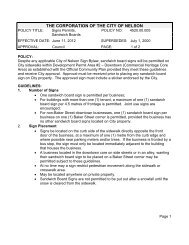
![OCP amendments - list [PDF - 201 KB] - City of Nelson](https://img.yumpu.com/39643637/1/190x146/ocp-amendments-list-pdf-201-kb-city-of-nelson.jpg?quality=85)

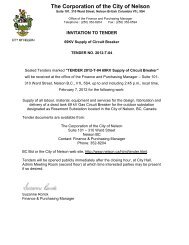
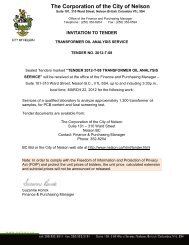
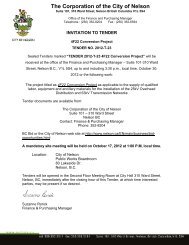

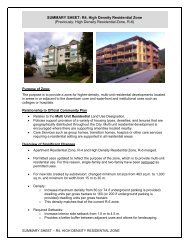
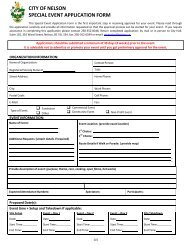
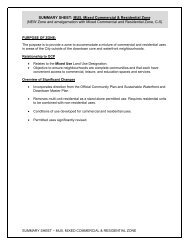
![Banner Request Application [PDF - 60 KB] - City of Nelson](https://img.yumpu.com/39643277/1/190x245/banner-request-application-pdf-60-kb-city-of-nelson.jpg?quality=85)